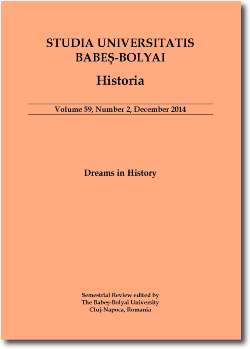THE AUSTRIAN CURRENCY REFORM OF 1857-1858 AND THE “TRANSYLVANIAN BOOKLETS PUBLISHED ON THE OCCASION OF THE ISSUANCE OF THE NEW CURRENCY”
DIE ÖSTERREICHISCHE MÜNZREFORM VON 1857-1858 UND DIE SIEBENBÜRGISCHEN “GELEGENHEITSCHRIFTEN ANLÄSSLICH DER NEUEN WÄHRUNG”. MIT BESONDERER BETRACHTUNG DER GESPRÄCHE DER BAUERN HANS UND GEORG ÜBER DAS NEUE GELD (1858)
Author(s): Philippe Henri BlasenSubject(s): History
Published by: Studia Universitatis Babes-Bolyai
Keywords: Austrian Empire; Transylvania; modern numismatics; everyday life; prices; language history.
Summary/Abstract: It is proposed in the present article to describe the various stages of the 1857-1858 monetary reform in the Austrian Empire and to analyse Transylvanian booklets explaining the provisions of the coinage treaty in layman's terms. The monetary reform was a major endeavour, which annulled the many currencies recognized as legal tender within the Austrian Empire, including the Lombardo-Venetian Kingdom, and introduced the decimal system, wherein 100 Kreuzer/1 Gulden replaced the previous 60/1 ratio. The new, so-called 'Austrian', currency was nevertheless complicated by the exchange rates of the old curriences, which created calculation problems. This is the reason why booklets were printed throughout the Empire to explain conversion and rounding rules to the general public. At least seven such booklets were printed in Transylvania, the foremost being a text by Prussian pedagogue Carl Unverricht. The explanations are laid out as a dialogue, following the catechetical method, or as a school drama script. Two peasants are portrayed, one as the teacher and the other as a pupil. The text includes details about the daily life of a peasant, as well as information on the currency circulation and the price level for the year. The booklet was translated into Romanian, using a mix of the Transylvanian speech variety, words crudely adapted from German, as well as a series of neologisms preferred by the Romanian intellectual elite of the time, showing the desire of the same elite to build a specialist vocabulary.
Journal: Studia Universitatis Babes-Bolyai - Historia
- Issue Year: 61/2016
- Issue No: 2
- Page Range: 69-92
- Page Count: 24
- Language: German

